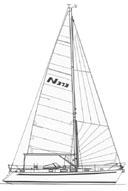Najad 373
Family cruiserr
The advantage this design has over the previous two is that it offers the privacy of an aft cabin separated from the rest of the interior by the length of the engine room. Of course with the engine located directly below the cockpit sole, access is much better than in the aft-cockpit designs where the engines are tucked under the companionway steps. The disadvantage to the center-cockpit approach is that the cockpit has been reduced to mini hot-tub proportions.
This Judel/Vrolijk hull is more shapely than the previous two. The stern is less broad, and with an L/B of 3.13, the boat is not as beamy. Certainly this reduction in beam is offset by the increase in displacement to a D/L of 249.
The rudder is a partially balanced spade on a half skeg. Again two keels are available drawing 6 feet, 3 inches and 5 feet, 2 inches. The keels show outside lead on a shared, molded-in root sump. This configuration provides a useful deep sump area and also helps get the VCG of the lead down. Neither keel is bulbed, but they both are slightly flaired at the tip with dead-flat bottoms, which may help prevent some crossover flow at the tip. The nicely sprung sheerline of this design is accented by a raised bulwark topped with a teak caprail.
This is an impressive interior layout showing very little evidence of having been squeezed into the boat. I like the layout of the saloon, which was obviously helped by spreading the galley down alongside the cockpit well. There are six drawers in this galley, drawers below the chart table and a plethora of lockers. The beautiful joinery, all done in African mahogany, is given a fine satin finish.
The double V-berth forward and the aft double berth both look more than adequate. The head is tight, but hey, it's the head. I like the opposing settee and drop-leaf table arrangement. While the lazarette has been sacrificed to the aft cabin, there is a large locker amidships just aft of the head. Being in the middle of the boat, this deck-accessed locker may have more useable volume than would a lazarette. I haven't seen many boats under 40 feet finished as well as this one.
This rig confuses me with its 16-inch offset between the headstay and the backstay. The brochure calls it a fractional rig, but I can't imagine what so small an offset is supposed to accomplish. Perhaps it's to make the mast easier to bend. But considering that the boat has both aft and forward lower shrouds, this doesn't look probable; fore and aft lowers make it harder to bend the mast. Maybe the idea is to keep the lower mast panel fixed so all the mast bend will be above the lower spreaders. Maybe the idea is to allow room above the headstay to fly a masthead chute with the offset leaving some room for the sock. I'm confused. I think a simple masthead rig would have been better.
I find this boat very good looking. The cabintrunk-sheer interaction is ideal. Even the windshield looks good and will make a great base for the dodger. Certainly in terms of deck detailing and displacement I think this boat would be a suitable offshore cruising boat.

Comments